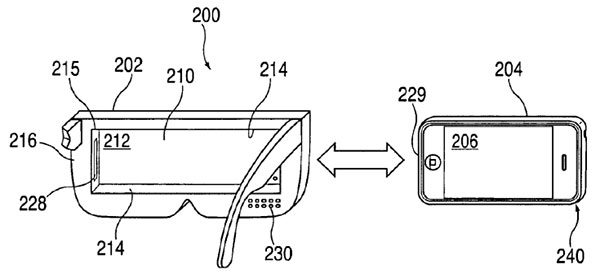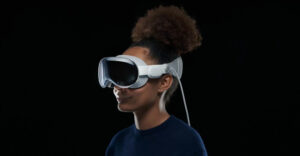Apple has been awarded a patent for a virtual reality headset that can use an iPhone or iPod as a display.
Patent number 8,957,835 was awarded by the U.S. Patent and Trademark Office to Apple for a “head-mounted display apparatus for retaining a portable electronic device with display.” The abstract describes a device similar to the Gear VR, which weds a Samsung Note smartphone to a headpiece designed by Oculus.
In its description of the patent, Apple explains that the head-mounted display system would allow users to couple and decouple a portable electronic device with a head-mounted device so the two devices would temporarily act as a single unit.
The portable electronic device — such as an iPhone — and the head-mounting device would be able to communicate with each other, the patent explained, and each device may be allowed to extend its features and services to the other to enhance, increase and eliminate redundant functions between the devices.

Quin C. Hoellwarth is listed as the inventor on the patent, which was filed in September 2008.
Apple did not respond to a request for comment for this story.
The Hybrid Advantage
While it’s possible to connect a portable device to a headset via a cable, Apple explained in its patent “a wired connection may be inconvenient and cumbersome for the user in certain situations.”
“In addition to being unwieldy,” it continued, “the coupled system often utilizes redundant features, which are not necessary when using the devices together. By way of example, each device utilizes a display screen, which adds cost, size, weight, and complexity to the entire system.”
“Accordingly, there is a need for an improved head-mounted display system, particularly a system that temporarily integrates or merges both mechanically and electronically a head-mounted device with a portable electronic device,” it added.
Currently, Samsung sells a similar hybrid VR headset for its Note 4 phablet. Priced at US$199, the Gear VR uses software written by Oculus, a VR headset maker purchased by Facebook last year for $2 billion.
One advantage a hybrid headset has over more conventional VR offerings is mobility, observed Eric Smith, an analyst in the digital consumer practice at Strategy Analytics. “It gets rid of the bulky game console or PC that one-piece headsets have to hook up to,” he told TechNewsWorld.
“You’re mobile,” he said. “You’re not tied down to something in the living room.”
Realism Versus Mobility
Ross Rubin, the principal analyst with Reticle Research added, “It lets you leverage a relatively powerful processor in the smartphone that’s mobile so you can enjoy the VR environment anywhere.”
There are other advantages, too. “Because it’s a connected device,” Rubin told TechNewsWorld, “you can bring in things relevant to where you are or what time it is or engage in real-time communication with people around you.”
As powerful as the processors in top-of-the-line smartphones are, they still pale in comparison to the chips in gaming systems or PCs, he noted. “The realism of the experience may not be as strong as it is with the Oculus Rift or Sony Morpheus,” Rubin said, “but what you give up in power and quality of experience, you make up for in mobility and accessibility in terms of price.”
“Since we’ve seen so much gaming go mobile,” Rubin continued, “this is chance for game developers to take advantage of virtual reality without having to develop for a PC or PS4.”
That could take some time, though, noted Smith, of Strategy Analytics. “It’s going to take awhile for developers to get their minds around developing for VR and finding the one or two killer apps that will drive the experience forward,” he said.
Hybrids Gaining Acceptance
At this point in their development, hybrids headsets like the one described in Apple’s patent and the Gear VR sold by Samsung are very similar.
“It’s such low tech,” observed Brian Blau, a research director at Gartner. “Some may be more comfortable than others, some connect to only certain devices.”
“They’re probably going to try and differentiate on smartphone apps,” he told TechNewsWorld, “and some will issue their own APIs so developers can build things for them.”
Even in their current nascent form, Blau does see the acceptance of hybrid headsets growing. “These devices are going to become popular,” he said. “They’re going to range from very cheap or free to a more sophisticated accessory.”
“Because of what they are,” he continued, “they’re not going to be as good as a more native virtual reality experience. I’m not saying they’re going to be bad. They’re just not going to be equivalent to their wired counterparts.”





















































